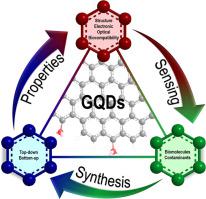Sensors and Actuators Reports Pub Date : 2022-11-19 , DOI: 10.1016/j.snr.2022.100130 Darwin Kurniawan , Ren-Jie Weng , Yan-Yi Chen , Michael Ryan Rahardja , Zetitty Cesario Nanaricka , Wei-Hung Chiang

|
Graphene quantum dots (GQDs) are zero-dimensional (0D) materials having unique luminescence properties due to quantum confinement and edge effect. Coupled with their large surface area, chemical- and photostabilities, biocompatibility, and low-toxicity, GQDs have enchanted many attentions for fundamental research and applications. In particular, the broad synthesis methods with ease of functionalization and controlled-synthesis as well as large variety of naturally available precursors, have made GQDs to be suitable for the development of advanced, rapid, and versatile optical-based biological and environmental sensors with high sensitivity and selectivity. In this review, we summarize the intrinsic knowledge about GQDs related to what properties make them interesting as nanosensors and further highlight the recent advances in their synthesis methods particularly from naturally available resources. Furthermore, fundamental sensing mechanisms will also be given to provide basic knowledge and a more comprehensive understanding to the readers about GQDs as luminescence-based biological and environmental nanosensors. The current limitations and prospects of GQDs are highlighted as the final conclusion of this review, hoping that the readers from various multidisciplinary natures to contribute their expertise and collaborate not only to improve the currently available GQD-based sensors but also to develop new sensing concepts which have never been realized.
中文翻译:

基于石墨烯量子点的生物和环境传感器的最新进展
石墨烯量子点 (GQD) 是零维 (0D) 材料,由于量子限制和边缘效应而具有独特的发光特性。加上它们的大表面积、化学稳定性和光稳定性、生物相容性和低毒性,GQD 吸引了许多基础研究和应用的关注。特别是,易于功能化和受控合成的广泛合成方法以及种类繁多的天然可用前体,使 GQD 适用于开发先进、快速和多功能的基于光学的生物和环境传感器,具有高灵敏度和选择性。在这篇评论中,我们总结了有关 GQD 的内在知识,这些知识与哪些特性使它们作为纳米传感器变得有趣,并进一步强调了它们合成方法的最新进展,特别是来自天然资源的合成方法。此外,还将提供基本的传感机制,为读者提供有关 GQD 作为基于发光的生物和环境纳米传感器的基础知识和更全面的理解。GQD 目前的局限性和前景作为本次审查的最终结论,希望来自不同学科的读者贡献他们的专业知识并合作,不仅改进目前可用的基于 GQD 的传感器,而且开发新的传感概念,从未实现。还将提供基本的传感机制,为读者提供有关 GQD 作为基于发光的生物和环境纳米传感器的基本知识和更全面的理解。GQD 目前的局限性和前景作为本次审查的最终结论,希望来自不同学科的读者贡献他们的专业知识并合作,不仅改进目前可用的基于 GQD 的传感器,而且开发新的传感概念,从未实现。还将提供基本的传感机制,为读者提供有关 GQD 作为基于发光的生物和环境纳米传感器的基本知识和更全面的理解。GQD 目前的局限性和前景作为本次审查的最终结论,希望来自不同学科的读者贡献他们的专业知识并合作,不仅改进目前可用的基于 GQD 的传感器,而且开发新的传感概念,从未实现。



























 京公网安备 11010802027423号
京公网安备 11010802027423号